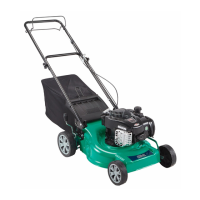46
If you can’t fix the fault yourself, contact your
nearest vendor. Please be aware that any
improper repairs will also invalidate the war-
ranty and additional costs may be incurred.
Disposal
Disposal of the appliance
This appliance must not be disposed of with
regular household waste! Dispose of the
appliance in the appropriate manner. For
more information, consult your community
waste disposal service.
Disposing of fuels and lubricants
Waste fuels, waste oils, and materials con-
taining oils (air filter, rags, etc.) may not get
into the environment.
– Bring waste materials that could damage
the environment to a collection point of
the dealer or in your community.
Disposal of the packaging
The packaging consists of card-
board and correspondingly marked
plastics that can be recycled.
– Make these materials available
for recycling.
Technical data
*) The specified values are emission values and do not necessar-
ily represent safe workplace values. Although there is a corre-
lation between emission and immission levels, this cannot be
used to infer whether additional safety measures are necessary
or not. Factors which affect the current immission levels at the
workplace, include the type of room, other sources of noise,
e.g. the number of machines operating and other processes
taking place in the vicinity. Permitted workplace values can dif-
fer from country to country. This information is designed to help
the user to better assess the dangers and risks.
**) The specified vibration emission value was measured in
accordance with a normed test procedure and can be used in
order to compare one tool with another. The specified vibration
emission value can also be used for an introductory evaluation
of the exposure. The vibration emission value may fluctuate
from the specified value during actual use of the power tool.
These fluctuations will depend on the way in which the power
tool is used. Try to keep vibrations to a minimum. One method
of reducing the vibration load is, for example, limiting the length
of time you work with the tool. All parts of the operating cycle
must be taken into account for this purpose (for example, also
including times in which the power tool is switched off and
times in which it is switched on, but is running without load).
Fuel and lubricants to be used
• Ordinary petrol, lead-free, 90 Octane If
there is no ordinary petrol available, use
petrol with a higher octane level.
• Motor oil: SAE 10W-30
Instructions for fuels
Fuels with ethanol mixtures (e. g. E10)
Fuels with high ethanol mixture are more
aggressive than fuels with less or without
ethanol mixture. Possibly painted surfaces
and plastics can be strongly affected or dam-
aged. Moreover, fuel with ethanol mixture
strongly reacts to influential factors such as
light rays, temperature and storage time.
Hence, these fuels should be stored only in
allowed containers and in suitable place for
not more than 30 days.
It is recommendable to empty the fuel tank
as well as the steam separator (carburettor) if
combustion engine takes longer time to shut-
down.
All our devices are suitable for using the E10
fuel.
Spare parts
Spare parts are available from your local ven-
dor.
WARNING! Risk of fire or environ-
mental damage! Avoid damage
caused by leaking fuel: drain the tank
prior to disposal.
Part number 401 165
Displacement 125cm³
Machine output 1,8kW
(3000min
-1
)
Tank capacity 800ml
Amount of engine oil 470ml
Working width 460mm
Cutting height 25–75mm
Number of steps 7
Volume of cutting bag 55l
Weight 22,5kg
Idle revolutions 3000min
-1
Noise power level
(L
WA
)*
96dB(A)
(K= 0,38dB(A))
Noise pressure level
(L
PA
)*
83dB(A)
(K= 3dB(A))
Vibration** 6,5m/s²
(K= 1,5m/s²)
Spark plug QC12YC
NOTICE! Risk to the environment,
fire hazard! Prevent damage from
occurring due to leaking fuel: Make
sure the tank is completely drained
before disposing of the device.
NOTICE! Risk of product damage!
Never use Bio-Ethanol E85 as fuel!
GB
Rasenmaeher_Benzin_401165.book Seite 46 Freitag, 8. April 2016 2:32 14

